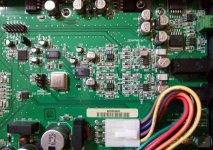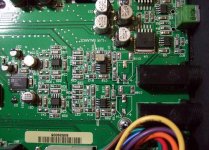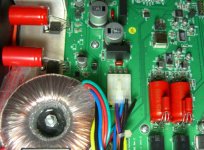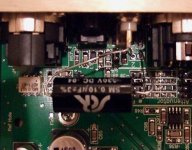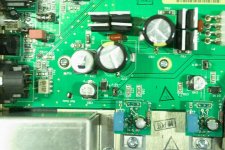Thanks for the update salas! Amazing how much one cap affects the Benchmark's sound, isn't it? Beyond anything in my experience. It's one of only two coupling caps in my system when playing digital sources yet appears far more sensitive than the cap in my amp.
I went back to the Blackgates. My system hasn't the bottom end to comment on slam but otherwise I agree pretty much 100% with your description. Overall though it was too much of a good thing in my tube SE / Tannoy Gold system. The effect is inadequately described as robbing the sound of life and jump factor. The Auricaps sounded great – smooth, big, expansive imaging, zero grit - but never startled. Perhaps the 0.22uF Auricap was too small. To misapply an engineering term, the net effect was 'over-damped'. Oddly, I had the same impression using them in my amp. And while unquestionably smoother up top the Auricaps (in my system again) err towards smoothing over some of the natural ugliness of real sibilance while the 100uF Blackgates added an odd 'hissy' texture to it. Adding a pair of 0.1 uF Blackgates in Super-E connection (engineering disclaimer #2, the manufacturer's description of Super-E reads as pure bunk. however it either has an effect or has none at all, so there was nothing to lose by using their recommendation. I didn't try the reverse) may have reduced this texture. I say 'may have' because it could have been the BG's notoriously long charge-up/break-in factor as well but it's improving. My suspicion is the 100uF BG N is the limiting factor and I'm hoping the NX Hi-Q selection, with their smaller physical sizes and voltage ratings more appropriate to this low voltage offset (based on Rubycon's claim of a charge up requirement), work better. Cheap enough to find out and I can always try the 2uF Auricaps later.
Note: pic below shows the caps tacked in for trial. The final install will place the bypasses where they belong, tight to the traces in place of the ceramics.
Edit: Oops, forgot to mention the BG bypasses on the supply. Had the extra caps in the junk box, tossed them in post-regulator to see if it had any effect. None that I could hear.
I went back to the Blackgates. My system hasn't the bottom end to comment on slam but otherwise I agree pretty much 100% with your description. Overall though it was too much of a good thing in my tube SE / Tannoy Gold system. The effect is inadequately described as robbing the sound of life and jump factor. The Auricaps sounded great – smooth, big, expansive imaging, zero grit - but never startled. Perhaps the 0.22uF Auricap was too small. To misapply an engineering term, the net effect was 'over-damped'. Oddly, I had the same impression using them in my amp. And while unquestionably smoother up top the Auricaps (in my system again) err towards smoothing over some of the natural ugliness of real sibilance while the 100uF Blackgates added an odd 'hissy' texture to it. Adding a pair of 0.1 uF Blackgates in Super-E connection (engineering disclaimer #2, the manufacturer's description of Super-E reads as pure bunk. however it either has an effect or has none at all, so there was nothing to lose by using their recommendation. I didn't try the reverse) may have reduced this texture. I say 'may have' because it could have been the BG's notoriously long charge-up/break-in factor as well but it's improving. My suspicion is the 100uF BG N is the limiting factor and I'm hoping the NX Hi-Q selection, with their smaller physical sizes and voltage ratings more appropriate to this low voltage offset (based on Rubycon's claim of a charge up requirement), work better. Cheap enough to find out and I can always try the 2uF Auricaps later.
Note: pic below shows the caps tacked in for trial. The final install will place the bypasses where they belong, tight to the traces in place of the ceramics.
Edit: Oops, forgot to mention the BG bypasses on the supply. Had the extra caps in the junk box, tossed them in post-regulator to see if it had any effect. None that I could hear.
Attachments
IMO, you will have a much better result with back-to-back BG FK series bypassed with Sonicap Platinums, .22 uFd. Of course DC-coupled is better. BTW, I think my DAC-1 mods are not too bad, even with all of the op-amps in:
http://www.6moons.com/audioreviews/empirical/offramp.html
Steve N.
Empirical Audio
http://www.6moons.com/audioreviews/empirical/offramp.html
Steve N.
Empirical Audio
RDF: I do insist you take a chance on 2uf/200V Auricaps once. Not mellow, no tightness in the lows. But then again you V1, me V2. Best check is with well known headphones IMHO so to exclude system factors to a good degree.
audioengr said:Of course DC-coupled is better. BTW, I think my DAC-1 mods are not too bad, even with all of the op-amps in
Steve, I have no doubts that DC-coupled is better. However, we did not find yet a "simple way" to implement it. Sebastiaan has an interesting approach, but I believe there must be a simpler one (e.g., minimize the DC ofset with minimal circuit changes and check/control its dependence with temperature). Do you use DC-servo in your mods? Or do you have any suggestion for us to implement DC-coupling?
Marin
P.S. I am a big fan of your mods. Initially I questioned some of them but, after learning more, I ended-up advocating them 🙂
salas said:Marin, what are your conclusions with BG couplers so far?
Salas, I believe that I got an improvement by using the 47uf NX Hi-Q, as suggested by Sebastiaan. But I am looking forward for a DC-coupled solution. As a first approach, I can try to use the offset trim capabilities of OPA627 and monitor how the DC offset (about 110mV in my DAC1) changes with temperature.
Marin
salas said:Not a big improvement or change? To Rdf and I changing caps sounded very pronounced.
I got a significant improvement just by changing the opamps (in particular, improved resolution, exceptional transient response and, overall, all the "dryness" in the sound was gone). All the other changes brought further refinement but, individually, could not match the opamp change. So maybe I have different expectations for "big improvement" 😀 Seriously, the black gates need a some time to deliver great sound. And I am sure that I did not loose anything (good) imediately after the change.
If you got so excited about this change, wait until you will change the 100nf caps on the digital input (before and after the pulse transformer). I will post some pics soon.
Marin
some upgrades
The attached picture shows some of the upgrades in my DAC1. In the lower right you can see new adjustable regulators (LT317 and LT337 using Eddie's boards). Now my opamps get +/-15.00V 🙂 In the upper left corner you can see new caps on the digital input (a BG NX Hi-Q and a red Wima, both 100nf). In the upper right are new soft recovery rectifiers from CREE. I changed also the main filtering caps (Panasonic FM 1800uf/35V). I intend to change the other SMD electrolytic caps as well, to lower the ESR. I also replaced all the six 10uf caps in the digital section with BG NX Hi-Q 22uf/6.3V to minimize the digital noise.
Now my DAC1 sounds pretty good. I had to replace my transport (Denon DVD player) with a MAC + Edirol UA-5 to fully appreciate all the changes 🙂 I intend to try a PC version as well, based on Steve's advice.
Marin
The attached picture shows some of the upgrades in my DAC1. In the lower right you can see new adjustable regulators (LT317 and LT337 using Eddie's boards). Now my opamps get +/-15.00V 🙂 In the upper left corner you can see new caps on the digital input (a BG NX Hi-Q and a red Wima, both 100nf). In the upper right are new soft recovery rectifiers from CREE. I changed also the main filtering caps (Panasonic FM 1800uf/35V). I intend to change the other SMD electrolytic caps as well, to lower the ESR. I also replaced all the six 10uf caps in the digital section with BG NX Hi-Q 22uf/6.3V to minimize the digital noise.
Now my DAC1 sounds pretty good. I had to replace my transport (Denon DVD player) with a MAC + Edirol UA-5 to fully appreciate all the changes 🙂 I intend to try a PC version as well, based on Steve's advice.
Marin
Attachments
Listened to the coax input cap and C108 (after transformer near JP7, in signal path too) substitution with SCR 0.1uF 630V Tin Foil.
They bring some more clarity in. A welcome notch up. Using the jumper for bypassing the digital input switch, fixed to coax helps a little too.
DAC-1 sounds top class when with very good output signal coupling caps and fast digital input caps. Highly recommended substitutions.
They bring some more clarity in. A welcome notch up. Using the jumper for bypassing the digital input switch, fixed to coax helps a little too.
DAC-1 sounds top class when with very good output signal coupling caps and fast digital input caps. Highly recommended substitutions.
Interesting things hapenning!
Hi Steve & thx. Is this recommendation based on better matching the DAC1's character or a preference in general over the NX Hi-Q.?
Hi salas. The small Auricaps went in for a brief stint but I'm way too happy with the BG-N now (with headphones too) that they've broken-in / come-up-to-charge / absorbed sufficient N-rays. I should have mentioned I'm a bit plastic-phobic, the Auricaps were the only plastic caps in my system's signal chain. I'll return to larger Auricaps in the future - as well as giving polyprop-tin a spin seeing how very highly Jim Hagerman and Allen Wright speak of these moderately priced caps elsewhere - but with eight NX Hi-Q caps on the way that experiment comes first. When my order arrives the first thing will be to replace the damaged output RCAs with a pair of Audionote silvers, the centre fed by a 150 ohm Mills and wired directly back to the opamp, bypassing the board traces.
I also hoped to play around with PS capacitance, however on closer examination am dismayed at just how many ceramic power supply bypasses are in this thing. They're everywhere. I might try a quartet of 47uF BGs directly at the output opamp rails.
"IMO, you will have a much better result with back-to-back BG FK series bypassed with Sonicap Platinums, .22 uFd.
Hi Steve & thx. Is this recommendation based on better matching the DAC1's character or a preference in general over the NX Hi-Q.?
Hi salas. The small Auricaps went in for a brief stint but I'm way too happy with the BG-N now (with headphones too) that they've broken-in / come-up-to-charge / absorbed sufficient N-rays. I should have mentioned I'm a bit plastic-phobic, the Auricaps were the only plastic caps in my system's signal chain. I'll return to larger Auricaps in the future - as well as giving polyprop-tin a spin seeing how very highly Jim Hagerman and Allen Wright speak of these moderately priced caps elsewhere - but with eight NX Hi-Q caps on the way that experiment comes first. When my order arrives the first thing will be to replace the damaged output RCAs with a pair of Audionote silvers, the centre fed by a 150 ohm Mills and wired directly back to the opamp, bypassing the board traces.
I also hoped to play around with PS capacitance, however on closer examination am dismayed at just how many ceramic power supply bypasses are in this thing. They're everywhere. I might try a quartet of 47uF BGs directly at the output opamp rails.
It will be great to hear about your findings. Yes, the tin foils are value champions and sound warm. I use them in my tube amp also. Next one I want to try in general is the Teflon-tin foil Vcap. I found 8k to drive and 120mV offset in my DAC1 so the 2 uF caps were the biggest fitting making the 20Hz. But overdamping I never got. In my system the Benchmark sounds HUGE especially with EL-34. Has Audionote type presentation. I don't know why it sounds so thin in so many other reported systems. I also listened to the stock DAC driving 10'' & 12'' active ATC monitors and it had much body. In the professional world engineers never told me it sounded thin in any studio. They said rather warm!
My main thing was to unlock it from residual low cost capacitor grain, because it deserves it.
But I remember that the demo unit I have evaluated did sound thin. Maybe it was V1 or something. You know, my speakers do provide +/- 2dB in room real world response @ 2m, studio monitors that professionals use, are that tight too, and the control rooms are treated. Maybe the DAC-1 is too tight for general fitting into the 'High-End' world. Can't be an accident that OPA-627 works for so many people and to me sounds leaden. There must be a different system and speaker match.
My main thing was to unlock it from residual low cost capacitor grain, because it deserves it.
But I remember that the demo unit I have evaluated did sound thin. Maybe it was V1 or something. You know, my speakers do provide +/- 2dB in room real world response @ 2m, studio monitors that professionals use, are that tight too, and the control rooms are treated. Maybe the DAC-1 is too tight for general fitting into the 'High-End' world. Can't be an accident that OPA-627 works for so many people and to me sounds leaden. There must be a different system and speaker match.
ByPassing of the DC blocking capacitor
I found some interesting info about bypassing DC blocking caps here. Here are two quotes:
I found some interesting info about bypassing DC blocking caps here. Here are two quotes:
One of the best and most expensive options is Black gate NX Hi-Q 47 uF 6.3 Volt bipolar. But other cheaper types are also an upgrade. We use AVX tantalums of 22uF / 16V in many upgrades.
...
Use a 10 - 100n PP cap of good quality, but not too big physical size. (because of noise injection). A speaker cap is no good here!
- Status
- Not open for further replies.
- Home
- Source & Line
- Digital Line Level
- Upgrading the Benchmark DAC 1?
